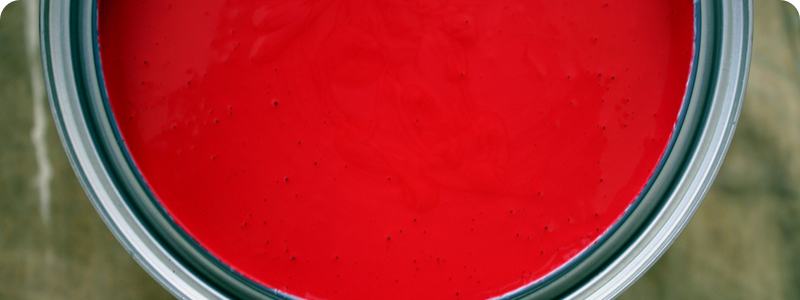
Painting. Sounds pretty simple doesn’t it? You whip out the ladder, the roller, the tray, the paint and get to work. Start in the corners and work your way in, right? Wrong. There are plenty of painting techniques and tips out there, and knowledge of them is actually pretty essential.
If you’d like to paint a few rooms and try your – somewhat shaky – hand at interior decorating, then you need to be versed in what to do with the expensive tin you picked out at the local hardware store. When in doubt, check out a couple DIY courses to get all the details.
Check it out:
[1] Paint The Trim First
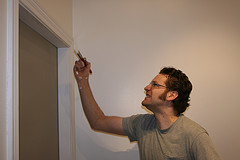 It’s tempting to get everything out and get involved, but you should follow a certain order when painting or you’re bound to run into trouble later on. This trouble will come in the form of lap marks, unsightly drips and colour mixing, all of which should be avoided. So, start with the trim or border in any room, then move to the ceiling and finish with the walls. When painting, it’s important to place drop cloths (to pick up drips and marks and prevent ruining your floor) and to tape up the seams where the wall meets the next one, to prevent mixing.
It’s tempting to get everything out and get involved, but you should follow a certain order when painting or you’re bound to run into trouble later on. This trouble will come in the form of lap marks, unsightly drips and colour mixing, all of which should be avoided. So, start with the trim or border in any room, then move to the ceiling and finish with the walls. When painting, it’s important to place drop cloths (to pick up drips and marks and prevent ruining your floor) and to tape up the seams where the wall meets the next one, to prevent mixing.
[2] Outside In
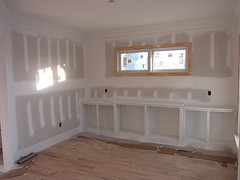 There’s not only an order in which you should paint the different bits of your room, but in the way you should paint the different sections of your wall. Start at the borders and apply an even base coat around the edges. It really doesn’t have to be perfect, but this is a great way to connect the rest of the wall with the edges, without creating unsightly smudges. Be sure to use long, smooth strokes to spread the paint evenly.
There’s not only an order in which you should paint the different bits of your room, but in the way you should paint the different sections of your wall. Start at the borders and apply an even base coat around the edges. It really doesn’t have to be perfect, but this is a great way to connect the rest of the wall with the edges, without creating unsightly smudges. Be sure to use long, smooth strokes to spread the paint evenly.
[3] Let It Dry
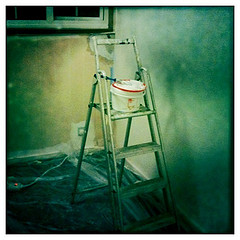 Since your paint will meet the tape at the seams, you’ll need to wait until it dries before you remove that tape. If you try this before it’s dried properly, you could end up with drip marks and uneven lines. Use a cutter to loosen the tape so you don’t pull off bits of paint.
Since your paint will meet the tape at the seams, you’ll need to wait until it dries before you remove that tape. If you try this before it’s dried properly, you could end up with drip marks and uneven lines. Use a cutter to loosen the tape so you don’t pull off bits of paint.
[4] Clean and Prime
 Before you set off painting your room, you need to clean your walls. This prevents marks and unevenness in the end finish. You can clean your walls with a soft cloth and some warm water – wait for it to dry after! After you’ve painted, priming helps prevent the finish from dulling or becoming uneven. Get your hands on a good primer and use a roller to feather it out along the wall.
Before you set off painting your room, you need to clean your walls. This prevents marks and unevenness in the end finish. You can clean your walls with a soft cloth and some warm water – wait for it to dry after! After you’ve painted, priming helps prevent the finish from dulling or becoming uneven. Get your hands on a good primer and use a roller to feather it out along the wall.
[5] Feather it
 Feathering paint is a good idea on ceilings when you can’t keep dipping your roller in the paint all the time. To achieve this affect, brush the paint on then roll it out quickly. Do this in different directions when running low on paint, then move onto the next section and repeat. After that, apply a second coat and run the roller in the opposite direction.
Feathering paint is a good idea on ceilings when you can’t keep dipping your roller in the paint all the time. To achieve this affect, brush the paint on then roll it out quickly. Do this in different directions when running low on paint, then move onto the next section and repeat. After that, apply a second coat and run the roller in the opposite direction.
[6] Mix Your Tins
 Create an even tone across the whole room, by taking your tins of paint and mixing them in one central bucket.
Create an even tone across the whole room, by taking your tins of paint and mixing them in one central bucket.
[7] Tint Your Primer
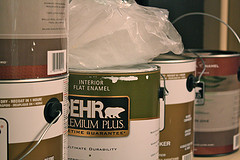 Primer help preserve the integrity of your finish, long after it’s… well, finished. Tinting the primer towards the colour of the wall will help make this tone more even.
Primer help preserve the integrity of your finish, long after it’s… well, finished. Tinting the primer towards the colour of the wall will help make this tone more even.
[8] Canvas
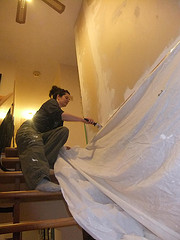 No, that’s not for the easel! Use canvas drop cloths instead of plastic ones, as they absorb paint drips easier and don’t get slippery and smudgy.
No, that’s not for the easel! Use canvas drop cloths instead of plastic ones, as they absorb paint drips easier and don’t get slippery and smudgy.
[9] The Wet Edge
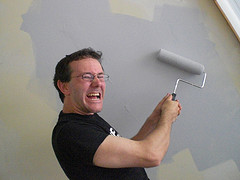 This basically means you keep the roller wet and are able to spread the paint with ease. To achieve this, start at the corner and run the roller up and down the full length of the wall in even strokes, and reload the paint often.
This basically means you keep the roller wet and are able to spread the paint with ease. To achieve this, start at the corner and run the roller up and down the full length of the wall in even strokes, and reload the paint often.
[10] Storage
If you’re done for the day and want to continue tomorrow, don’t clean everything off. Wrap your brushes in plastic wrap for the next day. They’ll keep just fine and you won’t have to set everything up from scratch.